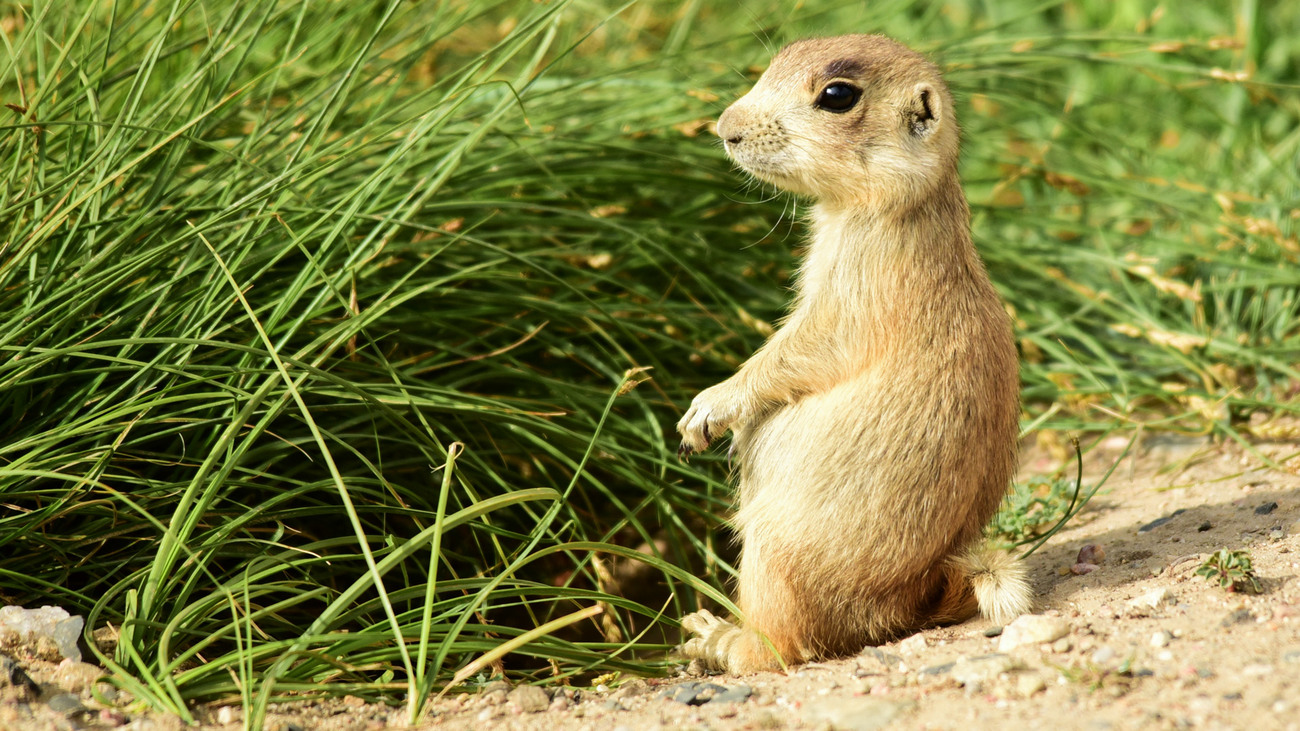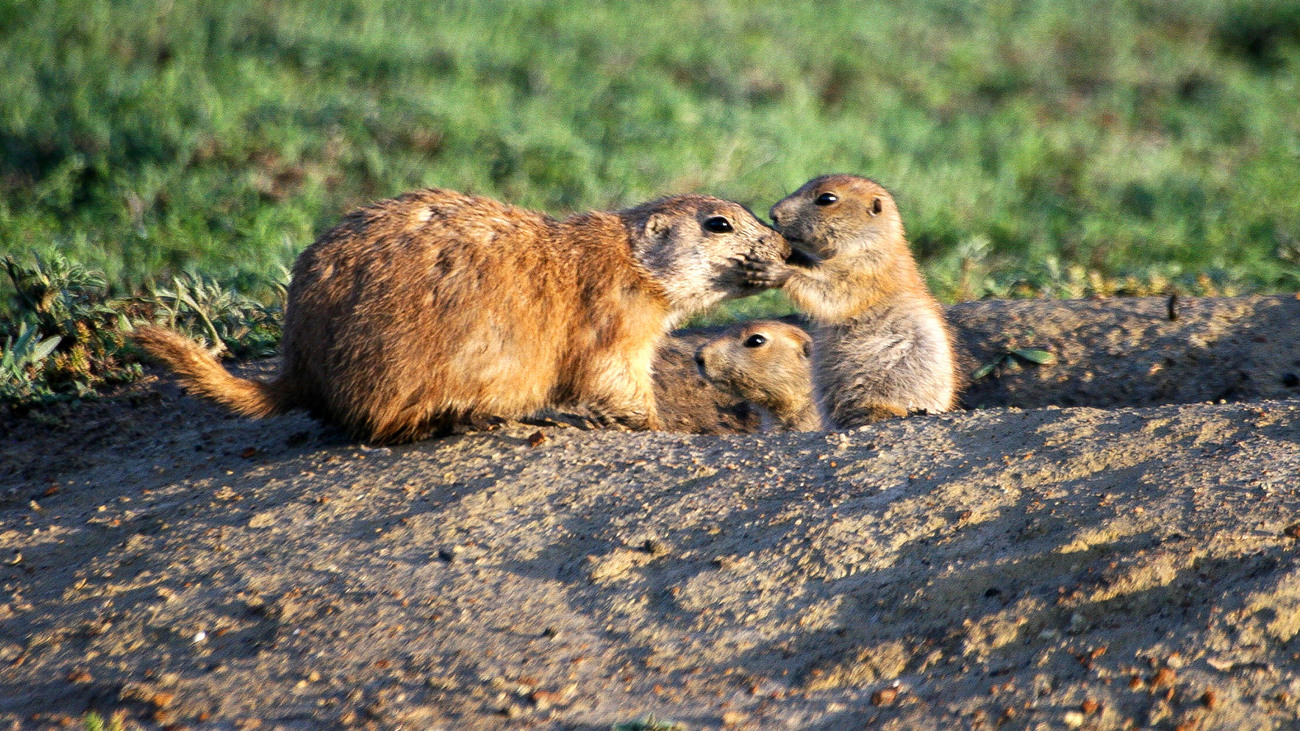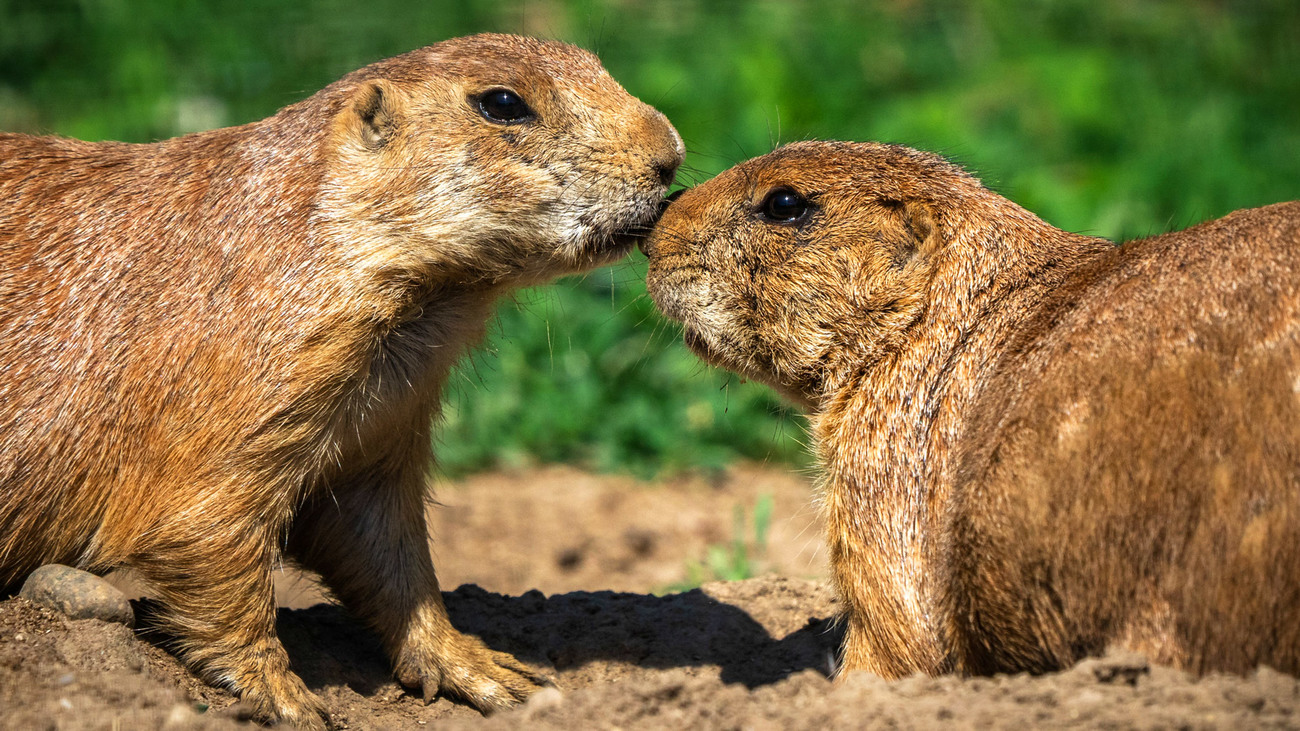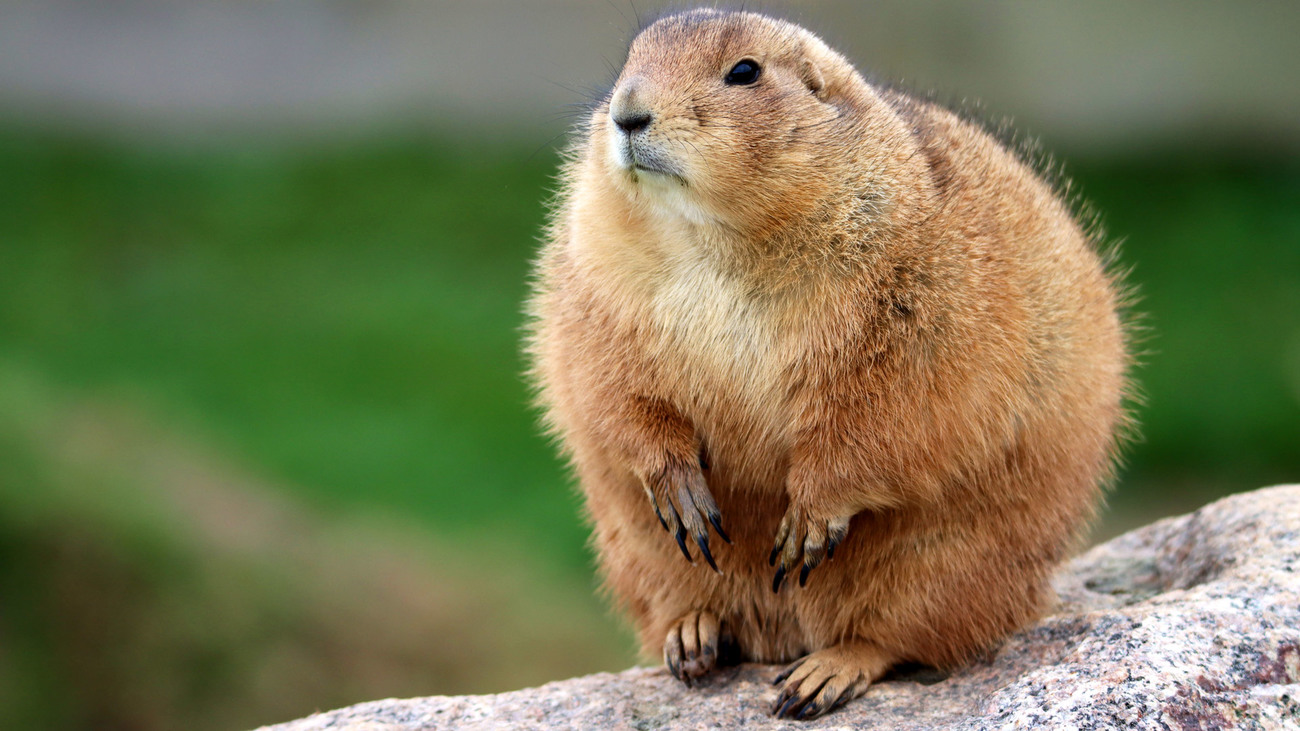Prairie dogs
Prairie dogs are members of the Scuiridae family and are closely related to ground squirrels and chipmunks. They’re a bit larger than their relatives, ranging from 28 to 33 centimeters in length and weighing up to 1.7 kilograms. Though not as long and fluffy as ground squirrels, prairie dogs have tails with different coloring depending on the species. Two species of prairie dog are named for their tail colors—the black-tailed prairie dog and the white-tailed prairie dog. Other species can have tails with both white and grey coloring.
Prairie dogs are known for making complex burrows underground, where they sleep throughout the year and stay warm during winter. During the moderate months, they spend most of the day foraging for their foods of choice—leafy plants, seeds, grasses, and roots during the fall. They stay close to their burrows to use them for shelter when a predator comes within range. Loud cries similar to a dog’s bark alert other colony members to the danger and signal them to take cover.
While colonies can consist of hundreds of millions of prairie dogs, they live in smaller family groups within these colonies. These groups contain one male, a few females, and their young. Families hunt together, share food, groom each other, and even play together. Mating happens in late winter or early spring, and females give birth to litters of up to 10 young after one month's gestation.
Prairie dogs serve their ecosystems by sharing their burrows with various other organisms. Snakes, owls, camel spiders, insects, rabbits, and even their own predators like black-footed ferrets can all be found living in prairie dog burrows. These burrows also promote water flow underground, which can benefit other animals and even humans living in dry areas. The act of digging burrows is environmentally beneficial because it stimulates the soil and encourages plant growth.
What is a prairie dog’s scientific name?
The prairie dog’s scientific name is Cynomys, and it refers to a genus of five species of burrowing rodents native to North America. In Greek, Cynomys means ‘dog mouse’ and refers to their dog-like warning calls and small size.
The five species of prairie dogs and their scientific names are:
- Gunnison’s prairie dog (Cynomys gunnisoni)
- White-tailed prairie dog (Cynomys leucurus)
- Black-tailed prairie dog (Cynomys ludovicianus)
- Mexican prairie dog (Cynomys mexicanus)
- Utah prairie dog (Cynomys parvidens)
Are prairie dogs endangered?
Of the five species of prairie dog, two are listed on the IUCN Red List as endangered. The Utah prairie dog and the Mexican prairie dog both have very small ranges, the Utah prairie dog in Utah and the Mexican prairie dog in Coahuila, Nuevo León, and San Luis Potosí. Their numbers are continuing to decline as human activities threaten their habitats.
The other three species, the black-tailed prairie dog, Gunnison’s prairie dog, and the white-tailed prairie dog, are listed as least concern. However, all three also show decreasing population trends and suffer from a range of threats such as disease, habitat loss, predation, and human activity.
Where do prairie dogs live?
The different species of prairie dogs live in different areas throughout North America.
The Mexican prairie dog lives in a small pocket of land in the middle of Mexico, covering parts of the northeastern states of Coahuila, Nuevo Leon, and San Luis Potosí.
The range of the Utah prairie dog has declined by about 90% over the past century, and it now inhabits an area of just 28 square kilometers in the state of Utah.
Gunnison’s prairie dogs live in Arizona, Colorado, New Mexico, and Utah, and white-tailed prairie dogs can be found in the Rocky Mountain valleys of eastern Wyoming.
The black-tailed prairie dog is both the most well-known and widespread species—they can be found anywhere from the Canadian prairies of Saskatchewan to northern Mexico.
All five species live in grassland habitats that can sustain their herbivorous diets and sleep underground in elaborate interconnected burrows. Some prairie dog ‘towns’ or colonies can cover hundreds of acres and house millions of prairie dogs.
Threats
Before 1800, the population of prairie dogs in North America was estimated at five billion. However, in the past two centuries, control programs and habitat loss have greatly reduced their numbers. Now, they face several continuing threats, including habitat loss, disease, predation, and human activity.

Disease
An exotic disease known as sylvatic plague is prevalent among prairie dogs and can be extremely dangerous during outbreaks. Because colonies are so close-knit, the flea-borne disease can wipe out 99% of colony members. The disease came to America around 1899 and has significantly reduced prairie dog numbers, especially white-tailed prairie dogs.
Habitat loss
Habitat loss has affected all five species of prairie dog, with loss of historical habitat ranging from 87-99% depending on the species. Humans have converted much of the prairie dogs’ habitat for crop agriculture, livestock grazing, energy development, and residential or commercial development. This land use reduces the plant life prairie dogs need to survive and forces them to move elsewhere.
Predation
As numbers dwindle due to other factors, predation becomes a bigger issue because predator demand is more likely to exceed the supply of prairie dogs. Natural predators of prairie dogs include black-footed ferrets, badgers, wolves, coyotes, bobcats, and birds of prey. The black-footed ferret feeds almost exclusively on prairie dogs and lives inside their burrows.
Human-wildlife conflict
Because much of prairie dog habitat has been converted by humans for agriculture, human-animal conflict has increased. Farmers consider the plant-eating rodents a threat to their crops, and their burrows, despite being environmentally beneficial, can cause problems with the soil of farms. To combat this perceived threat, there have been widespread poisoning campaigns and organized hunts to kill large numbers of prairie dogs. Individuals also shoot and poison smaller numbers of prairie dogs on their own land.
FAQs
Why are they called prairie dogs?
Prairie dogs are rodents and not part of the same family as dogs. They earned the name thanks to the prairies they call home and the warning calls they make, which sound similar to a dog’s bark. Early French settlers in the US called them petit chiens, meaning ‘little dogs’.
What is the difference between a prairie dog and a meerkat?
While they look similar and sometimes get mistaken for each other, meerkats and prairie dogs are not the same. Prairie dogs are native to North America, while meerkats are native to Africa—so you’ll never see the two in the same place.
They also have different diets, with meerkats eating insects, grubs, arachnids, and small mammals, while prairie dogs are herbivores that live on plants and seeds. Due to the colder environment in which they live, prairie dogs are also stockier and have larger fat stores than meerkats. To tell them apart by sight, look for black circles around their eyes—meerkats have black circles and prairie dogs don’t.

What do prairie dogs eat?
Prairie dogs are herbivores and eat a range of plants and grasses. They generally get most of their nutrients and water from the moisture-rich plants they eat, and they spend most of the daylight hours above ground foraging for these plants. In spring, they eat mostly leafy green plants. In the summer, they eat more seeds. In the winter, they eat stems and roots.
Where do prairie dogs live?
Prairie dogs live in North America’s plains, plateaus, and valleys. The largest recorded prairie dog colony in Texas had an estimated 400 million members.
How long do prairie dogs live?
The lifespan of prairie dogs differs between the sexes. Females live for eight years, while males live for five years.
Do prairie dogs hibernate?
Prairie dogs don’t hibernate, but they do engage in a similar behavior during the coldest days of winter called torpor. They still eat extra food to fatten up for winter so they can survive even if they can’t find food as often. When it’s too cold, they lower their body temperature, breathing rate, and metabolic rate to reserve energy and deal with the cold conditions. However, in torpor, prairie dogs remain awake and still conduct normal activities, just at a slower pace.
Are prairie dogs rodents?
Yes, prairie dogs are a group of five burrowing, colony-forming rodent species from the squirrel family. They also look fairly similar to ground squirrels, though they lack fluffy tails and have different coloring.
Are prairie dogs endangered?
Two of the five species of prairie dogs are endangered—the Utah prairie dog and the Mexican prairie dog. The estimated population of Utah prairie dogs is 8,000, with intensive poisoning efforts in the 20th century contributing to their decline. The Mexican prairie dog is found only in a 499-square-kilometre area in Mexico close to Monterrey. Their population is currently unknown, and they have lost at least 65% of their former habitat due to land use conversion, primarily for agriculture.
What is a group of prairie dogs called?
A large group of prairie dogs is called a colony or a town and is made up of smaller family groups called coteries. They make expansive burrow systems underground and live in groups that can consist of hundreds of millions of individuals—so even ‘town’ can be an understatement. Many other species that can’t dig their burrows also live in prairie dog towns, such as black-footed ferrets, desert cottontail rabbits, camel spiders, insects, prairie rattlesnakes, and more.

Why are prairie dogs a keystone species?
Keystone species have a particularly significant impact on their ecosystem, defining how it works. Prairie dogs fill this role in several ways. Prairie dogs provide an important food source for predators like wolves, coyotes, and bobcats. Their burrowing habits make homes for other animals, stimulate the soil for plant growth, and even encourage water flow in drought-prone areas of the US.
Are prairie dogs good pets?
Prairie dogs are not domesticated animals, so they do not make good pets. They are wild animals that thrive best when they’re left alone to live in their natural habitat. Keeping a prairie dog pet can also pose a threat to humans through the spread of zoonotic disease—a danger when keeping any kind of exotic pet. A range of diseases like mpox, SARS, HIV, Ebola, and avian flu all originated in wild animals before they were passed to humans.
Prairie dogs are particularly susceptible to a flea-borne bacterial disease called the sylvatic plague, which can also infect humans if they’re in close contact with prairie dogs and their fleas.
How can you help?
Prairie dog populations are threatened by disease, predation, habitat loss, and human-wildlife conflict. You can learn more about how IFAW is working to decrease human-wildlife conflict and build a future where animals and people can thrive together.
